Home » Jazz Articles » Live Review » Ottawa Jazz Festival, Days 1-3: June 23-25, 2011
Ottawa Jazz Festival, Days 1-3: June 23-25, 2011
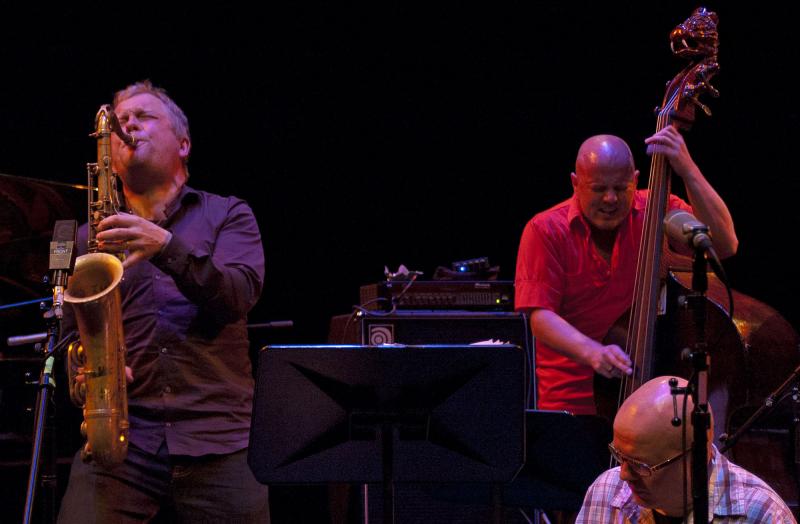
TD Ottawa International Jazz Festival
Ottawa, Canada
June 23-25, 2011
2011 represents something of a gamble—and no shortage of controversy—for the TD Ottawa International Jazz Festival. After a financial loss in 2010 that wasn't especially large in relative terms, but was nevertheless significant, the festival's Executive Producer, Catherine O'Grady, made the decision to open up the roster of a festival that has remained, until this year, a relatively pure jazz festival, while others have gone down a road of mixed programming that has some jazz fans asking "Is it still a jazz festival?"
A recent All About Jazz opinion piece, When is a Jazz Festival (Not) a Jazz Festival suggests one possible answer to that question. Ottawa's decision to bring some distinctly un-jazz—or, at best, peripherally jazz-related—acts to its largest venue has clearly caused concern for some, but the plain truth is that the festival's program remains predominantly jazz. With less than ten percent of the one hundred or so events scheduled during the festival's 11-day run stretching beyond the jazz purview, the festival retains it status, in no uncertain terms, as one of the country's best jazz festivals, while at the same time implementing some changes to not just address its bottom line, but to deal with another immediate problem facing most jazz festivals, if not in the world, then certainly in North America.
OIJF has known, for some time, that its predominant demographic is one of gray-hairs and no-hairs, and as the baby boomer begins entering retirement age and beyond, festivals like Ottawa need to address that problem, and they need to address it now. There's almost as much controversy surrounding the idea of attracting potentially non-jazz fans to a jazz festival, through programming acts that cater directly to them, as there is the debate of whether or not a festival that does so retains the right to call itself a jazz event. Still, anyone who grew up in the 1970s know that bringing fans to a new genre can absolutely happen through tangential exposure. Many rock fans moved, in the late 1960s and early '70s, from the rock of guitarist Jimi Hendrix to the jazz-rock fusion of Mahavishnu Orchestra through to trumpeter Miles Davis, and beyond.

There may be a less-than-obvious connection, perhaps, from ex-Led Zeppelin front man Robert Plant and his current Band of Joy project, but who's to say some of the people attracted to Confederation Park Main Stage shows like Plant, Elvis Costello, k.d. lang, or James Cotton and Lucky Peterson won't arrive early, and find much to enjoy in the Great Canadian Jazz series, running at 6:30 each evening at the nearby Canal Stage, where it's possible to check out some terrific national acts including Ottawa's own Brian Browne and Mike Essoudry Octet, or Montreal's superb Chet Doxas Quartet and Francois Bourassa Quartet?
There are some who bemoan the "relegation" of name acts to the smaller Studio (at the nearby National Arts Centre), but is it really such a bad idea to put acts like the duo of piano star Brad Mehldau and saxophonist Joshua Redman, bassist Christian McBride's Inside Straight, or pianist Vijay Iyer—acts far more appropriate to intimate venues than the larger scale of an outdoor park stage—in this acoustically lovely and, frankly, appropriate 350-seat space? And by giving these acts two performances each night, addressing the possibility that the venue might be too small for a single show? That, two days before Mehldau and Redman are to appear, the 7:00PM show is sold out but tickets remain available for the 9:00PM show certainly supports the festival's decision to place them in a smaller space.
The success of this radical shift in the festival's programming won't be truly known until it's played out, but it certainly doesn't seem to be a bad idea for jazz fans to see some of their favorite acts in such close quarters. The only real issue is that, for some, the Ottawa Jazz Festival is Confederation Park, and it's a gamble for O'Grady to attempt such a massive paradigm shift, but the truth is that if she doesn't make some changes, then the OIJF is heading in a direction where it could very easily fold, and in just a few short years.
The fact is: OIJF is still, unequivocally, a jazz festival, and there's plenty to be seen, each and every day, for those who want to ignore its few stylistic "transgressions." The Improv Invitational series remains a great choice at the NAC's even more intimate, club-like Fourth Stage, where Norwegian guitar innovator Eivind Aarset's Sonic Codex will shake up preconceptions; Canadian pianist Nancy Walker—also a member of local bassist John Geggie's trio that hosts the Late Night Jam Sessions at the Arc Hotel—brings the quartet responsible for her latest release, New Hieroglyhphics (Self Produced, 2011); British upstart Phronesis is set to post its distinct (and distinctly youthful) version of the jazz piano trio; and Swiss trumpeter Erik Truffaz brings his latest electric quartet. In addition to more centrist groups like Mehdlau/Redman, McBride and vocalist Kurt Elling, there's also an opportunity to experience jazz on the extreme edge, when OIJF hosts Scandinavian acts The Thing, saxophonist Jonas Kulhammer's Quartet and Atomic to the Studio Series.

Meanwhile, at the OLG stage, introduced in 2010 at the opposite end of Confederation Park, the OLG Late Night Series brings some fresh faces to the festival—and with a distinctly youthful bent—with scheduled performances by groove-meisters Soulive; contemporary big band composer/arranger Darcy James Argue's critically acclaimed Secret Society; and, from Norway, the always-innovative, always-exciting Jaga Jazzist.
So, the "jazz" in the TD Ottawa International Jazz Festival may have moved largely indoors, or to another stage, but it's still the predominant face of a festival that, in its 31st year, has decided to shake things up in the interest of remaining viable by both bolstering its bottom line with some large-scale draws, and to reinvent itself as a festival that can, at least, begin building an audience that will allow it to continue and, hopefully, thrive well into the future.
Chapter Index
June 23: Bahamas / Robert Plant Band of Joy
Festivals spend months planning, but for those who bring their largest acts to an outdoor venue, no amount of forethought can take care of the weather. With rain and thunderstorms hitting Ottawa hard throughout the first day of OIJF 2011, it sure seemed like its hopes for a big first night, kicked off by Robert Plant's Band of Joy, was in jeopardy. But as thousands of fans waited for the doors to open, and as photographers collected on a new scaffold—distanced from the stage itself, at Plant's request, and looking like a pretty darn good lightning rod—something curious seemed to be happening. Everywhere you looked there were jagged bolts of lightning and ominous rainclouds dropping rain elsewhere in the city, but Confederation Park seemed to be situated in the eye of the storm, with the precipitation holding off until about 20 minutes before the end of Plant's set. Even then, it was a relatively light rain that began to fall on 11,000 fans at around 10:10PM—a far cry from the torrential downpour of a few years ago, when the supergroup of saxophonist Wayne Shorter, pianist Herbie Hancock, bassist Dave Holland and drummer Brian Blade tested the true mettle of local jazz fans.
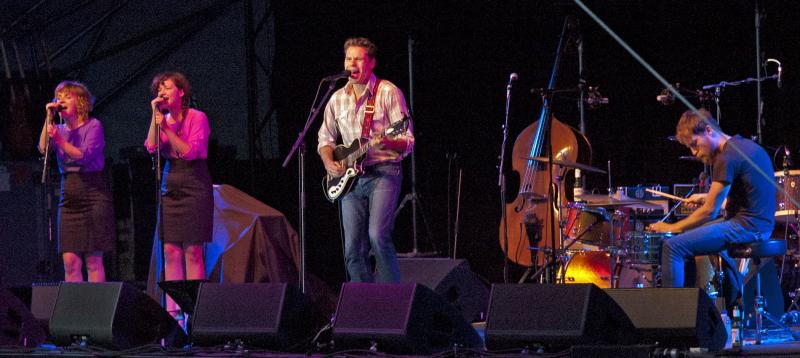 Bahamas, from left: unidentified singers, Afie Jurvanen, Jason Tait
Bahamas, from left: unidentified singers, Afie Jurvanen, Jason TaitBut this was rock and roll, appealing to a broader demographic used to a little suffering to see their stars, and so if the threat of thunderstorms prevented some from making the trek downtown to Confederation Park, it did raise the question: could the park have actually accommodated many more people anyway?
Whatever the answer to that question—and it may be one tested later in the week with some of the other major acts coming to the stage—for those coming to hear Plant, being in that eye of the storm was, perhaps, a surreal experience, but one which the aging rock star leveraged to his advantage during his 90-minute set.
Toronto's Bahamas delivered a solid warm-up set that put the audience in an even better mood than it already was when it came through the gates. Bahamas is Afie Jurvanen's stage moniker, though the singer/songwriter/guitarist often expands to a duo with drummer Jason Tait, as he did for his OIJF performance. Fleshing the group out even further, with the addition of two backup singers, Bahamas' lineup may have seemed a bit odd—just guitar and drums, with Jurvanen singing lead and his two women vocalists adding some glorious harmony—but it worked at a time when, more and more, young artists are arriving at the conclusion that the longstanding use of a conventional rhythm section need no longer apply. Still, while most artists who play with reduced instrumentation—like Norway's Jarle Bernhoft, who is a veritable one-man band—use technology to give them greater sonic breadth, and while he did, indeed, use some tastefully gritty overdrive and an octave divider that, at times, brought his instrument down to the bass range, Jurvanen avoided some of the usual electronic suspects in creating a larger sound, most notably any kind of looping device.
Bahamas' amicable alt-country approach worked well, and he somehow managed to imply much more going on with his guitar by hanging onto open string pedal tones, or leaping octaves from a low end riff to a high end scream. Tait may be a meat and potatoes drummer, whose primary purpose is groove, but his lazy, behind-the-beat rhythms and clearly simpatico interaction with Jurvanen gave the music plenty of oomph—and some brief moments of excitement, as the two headed into occasional, brief instrumental exchanges.
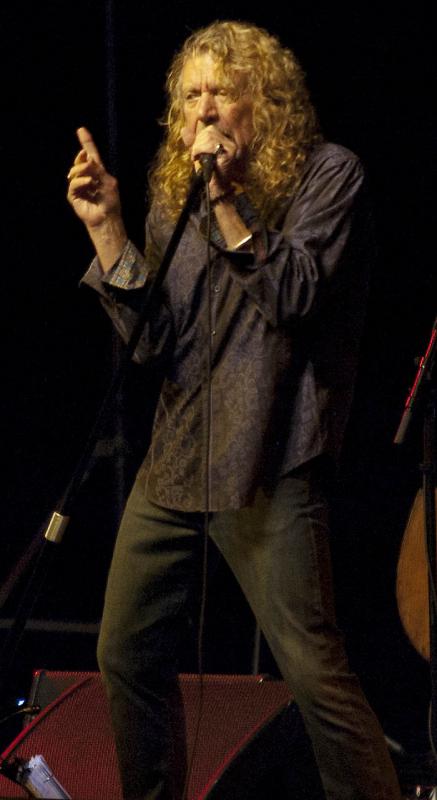 Still, Bahamas was clearly a warm-up, and when Plant took to the stage, just a few minutes after 9:00PM, he made it immediately clear that this was not just the reinvented singer who won a 2009 Grammy for Raising Sand, his 2007 Rounder collaboration with singer/fiddler Alison Krauss; this was a rock icon who has finally reconciled his undeniable past with a desire to remain relevant in the 21st century. Featuring the same group of outstanding musicians, many of them leaders in their own right, who appeared on his recent Band of Joy (Rounder, 2010)—guitarist/vocalist/producer Buddy Miller, recent Grammy winner, singer/acoustic guitarist Patty Griffin, stunning string instrument multi-instrumentalist Darrell Scott, master of all things bass Byron House, and drummer/percussionist Marco Giovino—Plant jumped right into a reinvention of Led Zeppelin's massive "Black Dog."
Still, Bahamas was clearly a warm-up, and when Plant took to the stage, just a few minutes after 9:00PM, he made it immediately clear that this was not just the reinvented singer who won a 2009 Grammy for Raising Sand, his 2007 Rounder collaboration with singer/fiddler Alison Krauss; this was a rock icon who has finally reconciled his undeniable past with a desire to remain relevant in the 21st century. Featuring the same group of outstanding musicians, many of them leaders in their own right, who appeared on his recent Band of Joy (Rounder, 2010)—guitarist/vocalist/producer Buddy Miller, recent Grammy winner, singer/acoustic guitarist Patty Griffin, stunning string instrument multi-instrumentalist Darrell Scott, master of all things bass Byron House, and drummer/percussionist Marco Giovino—Plant jumped right into a reinvention of Led Zeppelin's massive "Black Dog." Plant has long eschewed revisiting his Zeppelin days, but as he continues in his fifth decade of stardom, it's clear he's found a way to acknowledge his past without tarnishing his present. Deserting the thunderous riff that drove the original on the multi-million-selling Led Zeppelin IV (Atlantic, 1971), turned it into a slower, dirtier, even more visceral song, with the vocal harmonies (everyone in the group sang, making possible for some absolutely stunning five and six-part harmonies) turning it into a version recognizable enough to satisfy Zeppelin fans, but fresh enough to avoid any feeling of retro exploitation. Classic Rock? No. Classic? Absolutely.
"Black Dog" wasn't the only Zeppelin chestnut Plant rescued from the past with a modern facelift. Led Zeppelin II's "What Is and What Should Never Be" actually surpassed the original, as Plant demonstrating another quality more of his contemporaries should follow. In his Zeppelin days, Plant's range was so broad that he could just about hit notes so high only dogs could hear them. But with the passing of time, his range isn't what it used to be—though, in the range he does have (and it's still plenty wide), his voice remains strong and pure. Rather than try to hit those old notes, Plant reworked the vocal arrangement to pass them to Griffin in the chorus—and so seamlessly that it was only perceptible to those who were paying close attention. Elsewhere, on a driving version of Led Zeppelin IV's "Misty Mountain Hop," he alluded to the upper register screams without ever actually going there.
Plant also chose his material wisely, from a repertoire that, based on a BBC Radio 2 recording of his 2010 show at London's The Roundhouse, is plenty large enough for him to mix it up, night-to-night, and keep thing fresh and interesting for the band...and the audience. Band of Joy may have played IV's "Rock and Roll" and "Tangerine," from Led Zeppelin III (Atlantic, 1970) for the Roundhouse audience, but they didn't get "Black Dog" or "What is and What Should Never Be"; nor did they get an equally imaginative reinvention of "In the Mood," one of two tracks Plant culled from earlier post-Zeppelin solo albums including Principle of the Moment (Atlantic, 1983) and Fate of Nations (Atlantic, 1993), from which the set-opener, "Down to the Sea," was taken, though here Plant turned the originally tabla-driven, four-on-the-floor song into an angular piece of folk-rock, driven by Miller's gritty chords and visceral bends, and Scott's definitive acoustic guitar.
If it seems as though Plant's set was dominated by reaching back to the past, that couldn't be further from the truth. The singer's fifteen-song set (including one encore) also featured a number of tracks from Band of Joy, including even grungier versions of Los Lobos' "Angel Dance" and Richard Thompson's "House of Cards," which Plant introduced by revealing that, while he's spent much of his life looking to America for songwriting inspiration, at this point in his career it's a great time to revisit some of the great British songwriters, like Thompson.
Charismatic—and so comfortable onstage that moves which might have been poses for others were just a natural extension of his singing and interaction with the group—Plant's decades of experience meant that he couldn't help but own the stage, but he never hogged it. A generous leader, he regularly brought attention to the fine players around him, giving Miller a chance to shine in a throbbing, bluesy version of "Somewhere Trouble Won't Go"; Scott, a richly harmonized, countrified "Satisfied Mind"; and Griffin, a gospel-heavy "Ocean of Tears." Plant remained at the rear of the stage throughout these solo spots—clearly looking to avoid drawing attention to himself—singing harmony vocals, and coming to the front of the stage only briefly, for a harmonica solo during "Somewhere Trouble Won't Go," giving Miller, Scott and Griffin plenty of opportunity to prove they were as capable of owning the stage as he was.

Robert Plant and Band of Joy, from left: Buddy Miller, Robert Plant, Byron House
Patty Griffin, Marco Giovino (missing: Darrell Scott)
Unlike some older stars striving to avoid the ravages of time, Plant wears his life experiences proudly on his face—grizzly, wizened, and feeling absolutely authentic and natural, whether he was encouraging the audience to join in on "Black Dog," moving around the stage, microphone stand in hand, or facing into the group, when the energy level turned particularly high—as it did, many times during the performance.
But as hard-rocking as Band of Joy was, it was also a band capable of expansive dynamics, dropping to a hush at the start of "Satan, Your Kingdom Must Come Down," as Scott's spare banjo and Giovino's simple bass drum and high hat created a simple backdrop for six-part harmonies that were absolutely breathtaking, here and throughout the set. This may well be the best post-Zeppelin group Plant has ever had—perhaps, even, eclipsing that group. It may be blasphemy to harbor such a thought, but for artists who are doing more than cashing in on past glories as they head into their senior years, it's a certainty that every one of them appreciates their early successes, but prefers to focus on the present.
Ask most artists what their favorite music is, and more often than not, they'll tell you it's what they are doing now. In a succinct 90 minutes, Plant and his appropriately titled Band of Joy proved that it is, indeed, possible to look back without ever becoming stylistically pigeonholed—instead, reimagining the music of Plant's past with a paradoxically rootsy but modernistic bent.
June 25: Atomic
Two nights later, Scandinavia's Atomic delivered its own kind of high energy set—rock music, no, but certainly rocking music. With Swedish saxophonist/clarinetist Fredrik Ljungkvist the quintet's spokesperson, with comments like "Thank you thousand times, much. Nice town, Ottawa; tomorrow we leave for Toronto, perhaps you've heard of it?" it was clear that, while Atomic's music requires some serious players, it didn't preclude them from having all kinds of fun throughout their 80-minute set at the NAC Studio.
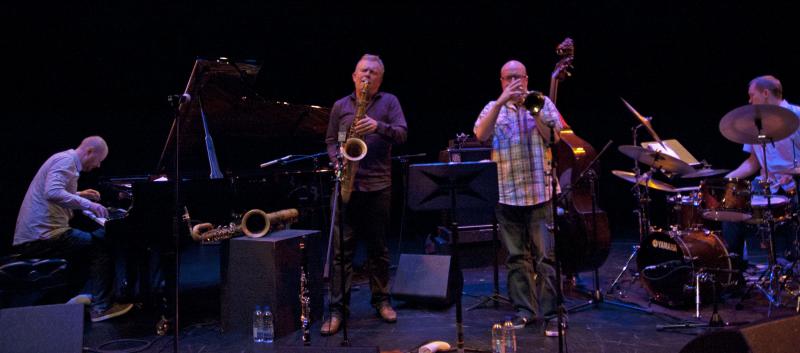
Atomic, from left: Håvard Wiik, Fredrik Ljungkvist
Magnus Broo, Ingebrigt Håker Flaten (hidden), Paal-Nilssen-Love
Ljungkvist is also a member of the recently formed The Deciders, having played at Bergen, Norway's Natt Jazz just a couple weeks prior. Both The Deciders (its music largely written by leader, Norwegian bassist Ole-Morten Vågan) and Mellow Motif—another Vågan project, featuring a different Atomic alum, Norwegian pianist Håvard Wiik—are clearly inspired/informed by the now ten year-old Atomic, even as the younger Vågan takes those groups in their own directions, heard most clearly on Motif's outstanding three-CD box, Facienda (Jazzland, 2010). But Atomic was there first, a quintet that belies a popular international misconception that all music coming from that part of the world all falls into the category of "Nordic cool." Atomic is no misnomer for this group that also features Swedish trumpeter Magnus Broo and, both from Norway, bassist Ingebrigt Håker Flaten and drummer Paal Nilssen-Love, who performed the previous evening at the same venue with The Thing, an outrageous improvising trio featuring the massively extroverted Swedish saxophonist Mats Gustafsson.
But as much as Atomic was capable of generating heat, it was not about an all-out and relentless sonic assault. Combining new music with tracks culled from the recent two-volume live Theatre Tilter (Jazzland, 2010), Atomic's two primary composers—Ljungqvist and Wiik—write music that's episodic, expansive in its reach and as likely to cull influences from contemporary classicism as it is from the American jazz tradition. And make no mistake, Atomic clearly comes from a lineage that blends, collage-like, the music of saxophone adventurers Ornette Coleman, Albert Ayler, Archie Shepp and Peter Brötzmann. The Brötzmann connection is particularly relevant, with Nilssen-Love a current member of the elder saxophonist's Chicago Tentet, and both the drummer and Flaten connecting through their work with another Brötzmann alum, veritable cottage industry mult-instrumentalist Ken Vandermark.
 Håvard Wiik
Håvard WiikThe set kicked into high gear immediately, with Wiik's "Green Mill Tilter," perhaps a nod to trumpeter Kenny Wheeler's recently uncovered classic, Windmill Tilter (Fontana, 1969). But Atomic's version of structure-driven free jazz is distanced from the expat Canadian trumpeter's characteristically melancholy music, though Broo does, at times, demonstrate the same remarkable control in the upper register that Wheeler has made a touchstone throughout his career. But Wheeler has never written music of such maelstrom-like intensity: a brief, swinging theme from the horns leading to a pulsating ostinato over which Broo's unbridled energy and occasionally gritty tone set a high bar for the set to come.
But if Broo is a virtuosic player with a tone that ranges from burnished to gritty, the rest of the members of Atomic had no trouble keeping up, and twisting and turning the free passages into directions so unexpected, that it was clear—from the eye contact, smiles and, at times, outright laughter amongst the group—that, ten years on, it's still playing with the same infectious energy, commitment and sense of fun that it did when it first came together. Ljungqvist, at one point, delivered a tenor solo of no small poignancy, in a passage where space was a sixth member of the group, but it wasn't to last, as he pushed forward into a groove-driven section where his expressive screams, squonks and wails were matched by Nilssen-Love's intuitive ability to anticipate where the saxophonist was going next, and meet him head-on.
Wiik was occasionally lost in the mix, at least in the front rows of the venue, as the horns and drums dominated, but his engagement was absolute throughout the set, as Atomic broke down, into various permutation and combination subsets, his early solo in "Green Mill Tilter," a marvel of seemingly reckless abandon, but always with a purpose.
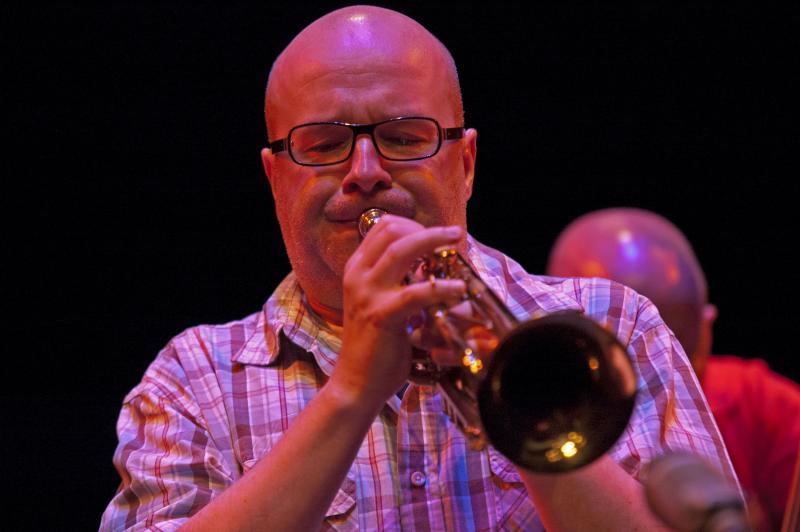
Magnus Broo
A purpose that was at the core of the entire set. Flaten's sawing arco, hard slapped pizzicato and excursions into riff-based groove were the fire in the engine room, along with Love, who combined loose, around-the-kit, ebbs-and-flows with plenty of swing, the occasional backbeat, and the kind of acutely interactive rubato playing that's a particular strength of the Scandinavian scene. But no matter how wild and extreme Atomic got, there was always a form around which the quintet rallied. At one point, during a Ljungkvist solo, he suddenly raised his right arm, and in a wide swoop, pulled the group back to form. It was the kind of strongly visual direction that Atomic has made a defining marker, and its Ottawa set was an exhilarating combination of complex, episodic writing and absolutely freewheeling and sometimes even hilarious improvisational interplay. The group received a well-deserved standing ovation from the roughly two-thirds capacity crowd, but they didn't ask for an encore, because after 80 minutes of Atomic, everyone needed a rest.
Coming up: Kurt Elling, Brad Mehldau/Joshua Redman, Return to Forever IV, Chet Doxas, and Pilc/Moutin/Hoenig.
Visit Robert Plant, Atomic and the TD Ottawa International Jazz Festival on the web.
Photo Credit
John Kelman
Days 1-3 | Days 4-6
< Previous
Unconditional
Next >
Opera
Comments
Tags
TD Ottawa International Jazz Festival
Live Reviews
John Kelman
Canada
Jimi Hendrix
Mahavishnu Orchestra
Miles Davis
Led Zeppelin
Elvis Costello
James Cotton
Lucky Peterson
Mike Essoudry
Chet Doxas
Francois Bourassa
brad mehldau
Joshua Redman
Christian McBride
Vijay Iyer
Eivind Aarset
Nancy Walker
John Geggie
Phronesis
Erik Truffaz
Kurt Elling
The Thing
Atomic
Darcy James Argue
Jaga Jazzist
Wayne Shorter
Herbie Hancock
Dave Holland
Brian Blade
Los Lobos
Richard Thompson
Fredrik Ljungkvist
Motif
Håvard Wiik
Ingebrigt Haker Flaten
Paal Nilssen-Love
Mats Gustafsson
Ornette Coleman
Albert Ayler
archie shepp
Peter Brotzmann
Ken Vandermark
Kenny Wheeler
For the Love of Jazz
 All About Jazz has been a pillar of jazz since 1995, championing it as an art form and, more importantly, supporting the musicians who create it. Our enduring commitment has made "AAJ" one of the most culturally important websites of its kind, read by hundreds of thousands of fans, musicians and industry figures every month.
All About Jazz has been a pillar of jazz since 1995, championing it as an art form and, more importantly, supporting the musicians who create it. Our enduring commitment has made "AAJ" one of the most culturally important websites of its kind, read by hundreds of thousands of fans, musicians and industry figures every month.






















